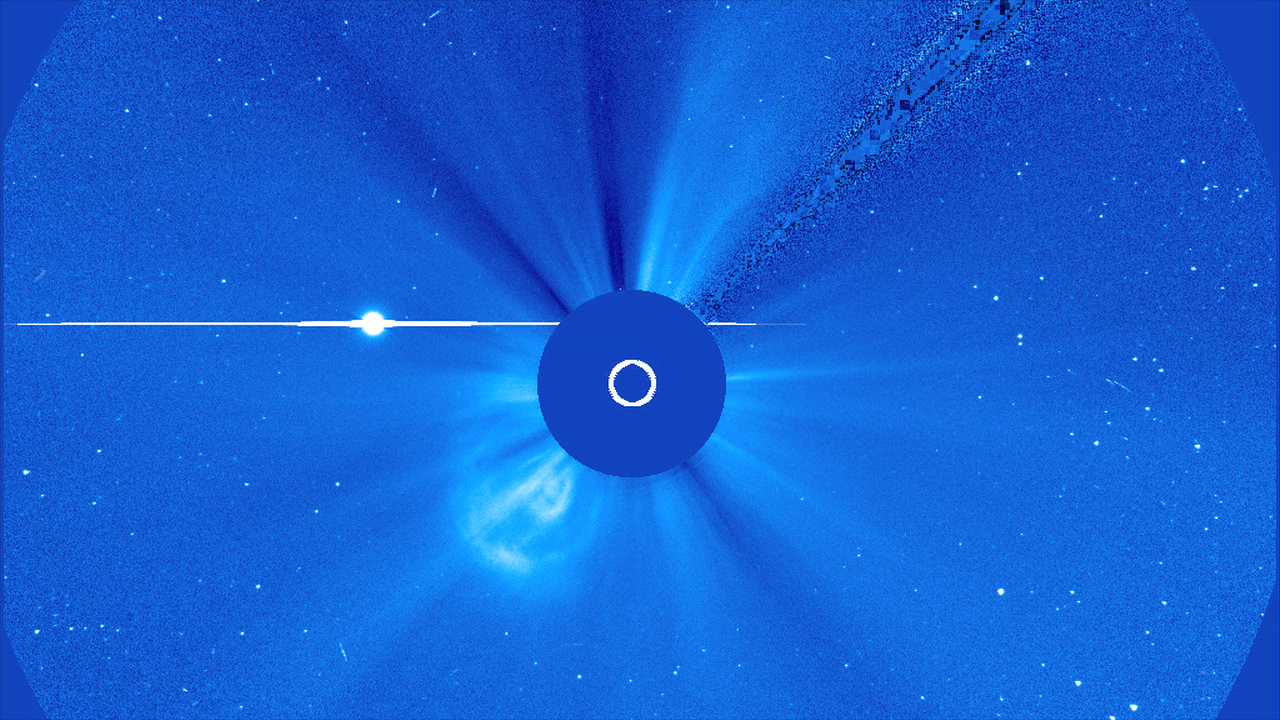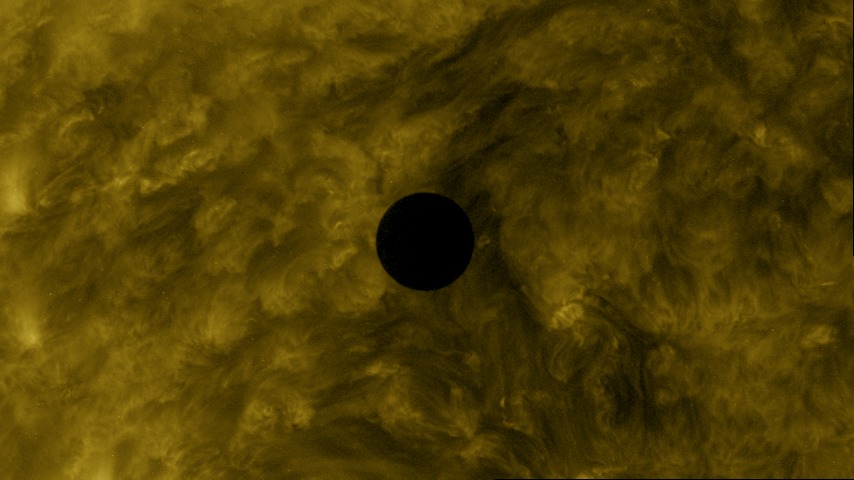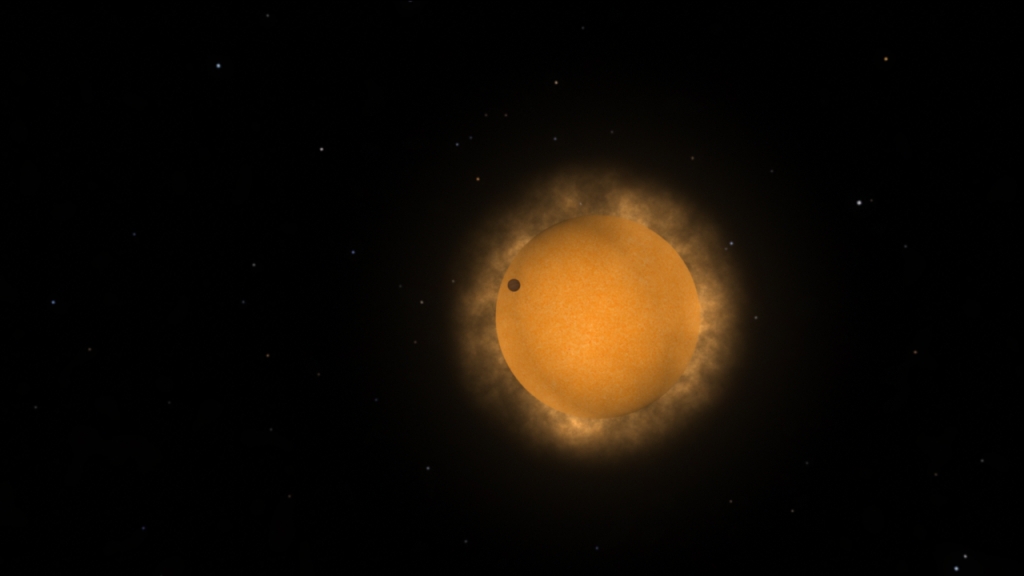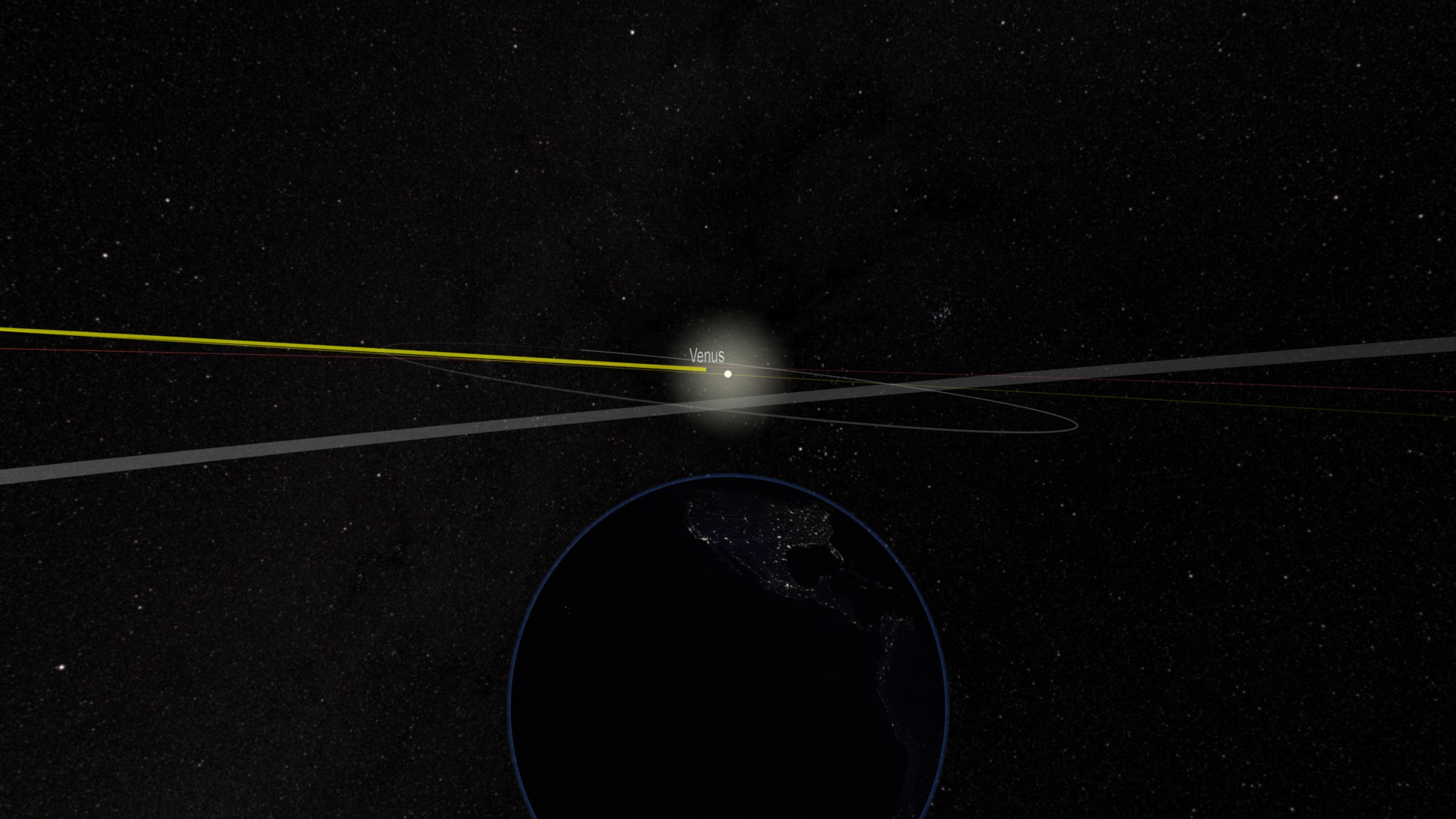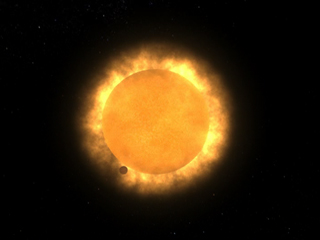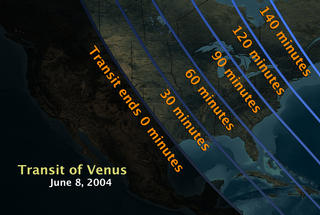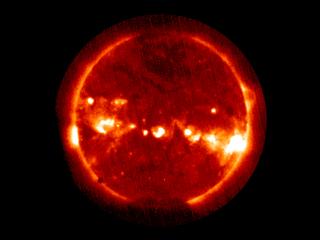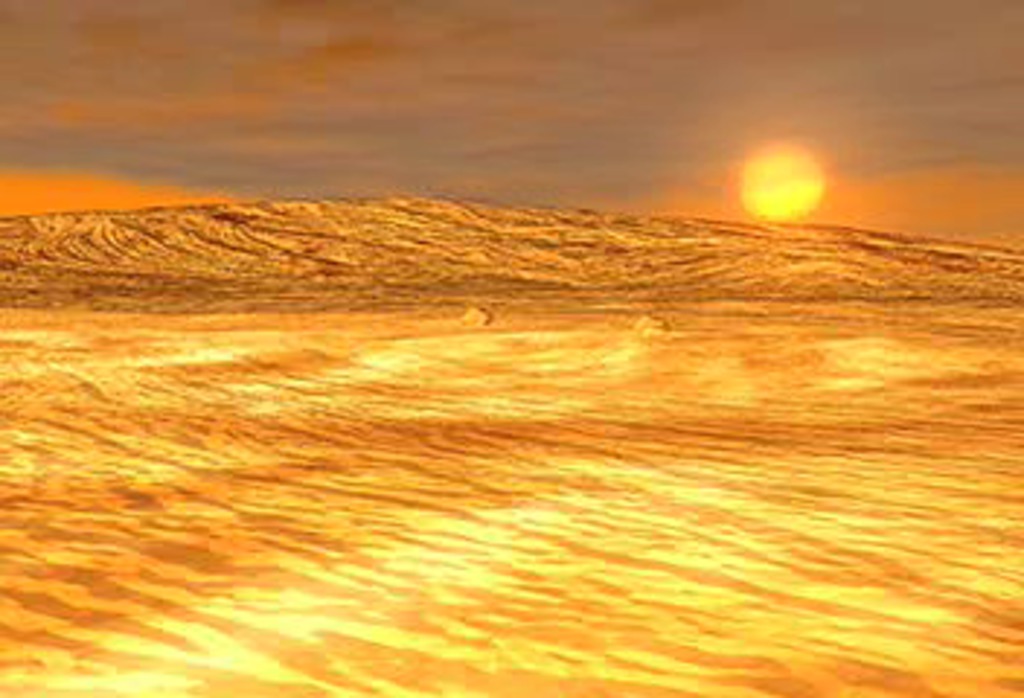2012 Venus Transit
Overview
This gallery contains visuals in support of the June 5, 2012 transit of Venus across the solar disk.
Visuals of 2012 Venus Transit
This section contains actual footage of the 2012 transit from the Solar Dynamics Observatory and pre-transit footage from SOHO.
SDO's Ultra-high Definition View of 2012 Venus Transit
Go to this pageLaunched on Feb. 11, 2010, the Solar Dynamics Observatory, or SDO, is the most advanced spacecraft ever designed to study the sun. During its five-year mission, it will examine the sun's atmosphere, magnetic field and also provide a better understanding of the role the sun plays in Earth's atmospheric chemistry and climate. SDO provides images with resolution 8 times better than high-definition television and returns more than a terabyte of data each day.On June 5 2012, SDO collected images of the rarest predictable solar event—the transit of Venus across the face of the sun. This event lasted approximately 6 hours and happens in pairs eight years apart, which are separated from each other by 105 or 121 years. The last transit was in 2004 and the next will not happen until 2117.The videos and images displayed here are constructed from several wavelengths of extreme ultraviolet light and a portion of the visible spectrum. The red colored sun is the 304 angstrom ultraviolet, the golden colored sun is 171 angstrom, the magenta sun is 1700 angstrom, and the orange sun is filtered visible light. 304 and 171 show the atmosphere of the sun, which does not appear in the visible part of the spectrum. ||
SOHO LASCO View of Approaching Venus Transit
Go to this pageThe LASCO C2 and C3 coronographs on board the SOHO spacecraft have been watching the approach of Venus for its last solar transit until 2117.With coronagraphs, the Sun is being blocked by an occulting disk, seen here in blue, so that SOHO can observe the much fainter features in the Sun's corona. The actual size of the Sun is represented by the white disk. The transit of Venus begins tomorrow, June 5, at about 6pm Eastern Daylight Time, or about 10pm Universal Time. It will last approximately 6 hours. ||
Venus Transit 2012 from Solar Dynamics Observatory
Go to this pageFull disk and Tracking views of Venus Transit from Solar Dynamics Observatory (SDO). It includes images taken by the Helioseismic and Magnetic Imager (HMI) and the Atmospheric Imaging Assembly (AIA).These are the basic images, collected from the telemetry. To see the insets composited, see Venus Transit 2012 Composited Visuals. ||
Venus Transit 2012 Composited Visuals
Go to this pageThese visualizations were generated by compositing the small field-of-view, high-cadence closeups of Venus with the full-disk, low-cadence imagery from Solar Dynamics Observatory (SDO). Two different instruments are used: the Helioseismic and Magnetic Imager (HMI) which sees light in the visible range, and the Atmospheric Imaging Assembly (AIA) which sees light in several wavelengths in the ultraviolet range. To find out more information about these instruments, check out The Atmospheric Imaging Assembly Tutorial.Some artifacts may be visible from the compositing, but you have to look pretty closely to see them.The color table threshold was raised for these images, reducing the amount of noise visible in the images. Note: There is an interesting artifact worthy of mention and clarification, and that is as Venus crosses the solar limb, the limb appears to be visible through the planet in some of the imagers (most notably the ultraviolet channels). Discussion with the scientists who built the imagers suggest this might be 'crosstalk' between the readouts of the four CCD panels that make up a complete image. It is an artifact of the imaging system. ||
Previsualizations of 2012 Transit
This section contains visualizations of the mechanics of the transit and what it will look like from Earth. The first video is an animation starting on Venus and traveling out to Earth to show the transit. The second video is a data-driven visualization of the relative orbits of Venus and Earth. It then zooms in to show the view from Earth of the transit.
2012 Venus Transit
Go to this pageMovie showing an artist's conception of the 2012 Venus transit. Starting on the surface of Venus, the camera pulls up through the planets clouds and flies back towards Earth to watch Venus's transit accross the Sun. ||
Venus Transit - 2012
Go to this pageIt was your last chance for the next 105 years.A transit is when a planet passes directly between the Sun and the Earth and we see the planet as a small dot moving slowly across the face of the Sun. A Venus transit occurred in 2004 (see Venus Transit from GOES/SXI). Prior to that it was 1882. The last Venus transit occurred on June 5-6, 2012 and the next one won't occur until 2117 (See the NASA Eclipse Web Site).To understand the significance of these events, it helps to know the history of how the Venus transits provided one of the first estimates of the size of the Solar System, and eventually the Universe (see A Brief History of the Transit of Venus).In this visualization, there are a few things which should be noted. 1) The camera view is NOT from anywhere on the surface of the Earth, but corresponds to an observer positioned along the Earth-Sun line, but over the north pole of the Earth. This causes the path of Venus to cross the solar disk lower (closer to the solar equator) than it would appear to an observer on the surface of the Earth.2) The ephemeris used for computing the planetary positions was not the high-precision JPL ephemeris (DE-421), but a lower-precision approximation. Yet, when tracked in detail, the transit takes place only about five hours later. It was decided that since the view of the transit in this visual does not correspond to any actual location ON the Earth, it might be misleading to present high-precision timing of the event.This visualization was developed for conceptual illustration and not meant for precision scientific use. ||
2004 Venus Transit Materials
This section contains visuals for the last Venus transit in 2004. It includes footage of the transit from the GOES spacecraft, which captured the transit in X-rays.
Conceptual Venus Transit
Go to this pageA close-up animation of the Venus transit. || A close-up view of the Venus transit. || Closeup_pre.00002_print.jpg (1024x768) [42.6 KB] || Closeup_thm.png (80x40) [20.0 KB] || Closeup_pre.jpg (320x240) [51.2 KB] || Closeupsml_pre.jpg (320x240) [51.2 KB] || Closeupsml_pre_searchweb.jpg (320x180) [53.9 KB] || Closeup.webmhd.webm (960x540) [929.9 KB] || Closeup.mpg (720x486) [4.6 MB] || Closeupsml.mpg (360x240) [1.7 MB] ||
From Venus to Venus Transit
Go to this pageAn artist conception of the surface of Venus to Venus transit ||
Venus Transit from GOES/SXI
Go to this pageThe planet Venus is seen passing between the Earth and the Sun in this sequence of images taken by GOES/SXI. The last Venus Transit was in 1882, the next will be in 2012. ||
Venus Transit 2004
Go to this pageMovie showing an artist's conception of the view of the Sun from under the clouds of Venus. || transit_pre.00002_print.jpg (1024x698) [116.6 KB] || transit_thm.png (80x40) [16.4 KB] || transit_pre.jpg (320x238) [13.4 KB] || transit_pre_searchweb.jpg (320x180) [90.3 KB] || VenusTransit_NTSC.webmhd.webm (960x540) [4.3 MB] || VenusTransit_640x480.m1v (640x480) [15.4 MB] || frames/720x480_4x3_30p/ (720x480) [128.0 KB] || VenusTransit_NTSC.m2v (720x480) [31.7 MB] || a010029_VenusTransit_NTSC.mp4 (640x480) [7.6 MB] || transit.mpg (352x240) [7.2 MB] || VenusTransit_320x240.m1v (320x240) [4.2 MB] ||

